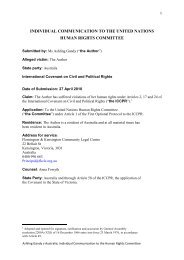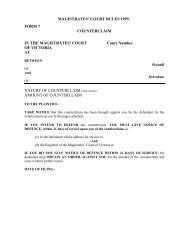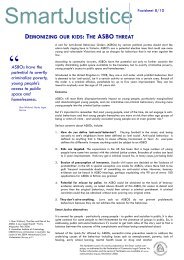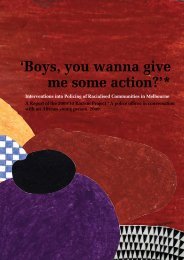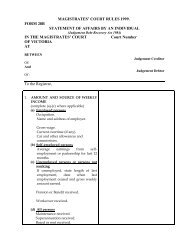Reducing Ethnic Profiling in the European Union - Open Society ...
Reducing Ethnic Profiling in the European Union - Open Society ...
Reducing Ethnic Profiling in the European Union - Open Society ...
- No tags were found...
You also want an ePaper? Increase the reach of your titles
YUMPU automatically turns print PDFs into web optimized ePapers that Google loves.
for <strong>the</strong>ir suspicion, reduc<strong>in</strong>g <strong>the</strong>ir tendency to rely on “suspicious behavior or attitude”as grounds and “o<strong>the</strong>r” as <strong>the</strong> type of stop. These demands, comb<strong>in</strong>ed with<strong>the</strong> scrut<strong>in</strong>y of <strong>the</strong> ethnic data, required officers to th<strong>in</strong>k much more carefully aboutwho <strong>the</strong>y were stopp<strong>in</strong>g and why. It led to a significant reduction <strong>in</strong> officers’ use ofstops (by roughly half) and a tripl<strong>in</strong>g of <strong>the</strong> hit rate.Police managers also used <strong>the</strong> stop data to assess <strong>the</strong> productivity of specific operations.In <strong>the</strong> case of a counter-terrorism operation that consisted primarily of stopp<strong>in</strong>g<strong>in</strong>dividuals at <strong>the</strong> tra<strong>in</strong> station, <strong>the</strong>y found that <strong>the</strong> identity controls and stopsand searches were produc<strong>in</strong>g highly disproportionate stops of Moroccans and nopositive results <strong>in</strong> terms of arrests or citations. Dur<strong>in</strong>g <strong>the</strong> operation, persons ofMoroccan orig<strong>in</strong> were be<strong>in</strong>g stopped 9.6 times more often than white Spaniards;once it was ended, this ratio went down to 3.4 to 1.Where us<strong>in</strong>g stop forms to collect ethnic data is a rout<strong>in</strong>e practice, officers becomeaccustomed to it and, arguably, <strong>the</strong> impact on <strong>the</strong>ir behavior may dim<strong>in</strong>ish over time.Such habituation can be addressed by a cont<strong>in</strong>ued emphasis on non-discrim<strong>in</strong>ationand cont<strong>in</strong>ued scrut<strong>in</strong>y of possible ethnic profil<strong>in</strong>g. In <strong>the</strong> United K<strong>in</strong>gdom, <strong>the</strong> Policeand Crim<strong>in</strong>al Evidence (PACE) Act Code of Practice places a statutory duty on supervisoryofficers to monitor <strong>the</strong> use of stop and search powers, consider<strong>in</strong>g <strong>in</strong> particular:“whe<strong>the</strong>r <strong>the</strong>re is any evidence that <strong>the</strong>y are be<strong>in</strong>g exercised on <strong>the</strong> basis of stereotypedimages or <strong>in</strong>appropriate generalisations.” 192 The code recommends that supervisory officersexam<strong>in</strong>e <strong>the</strong> stop records to identify any trends or patterns that give cause for concern;it calls for such monitor<strong>in</strong>g to be supported through <strong>the</strong> compilation of statisticalrecords of stops and searches by every police service. In practice, British police servicesvary considerably <strong>in</strong> <strong>the</strong> degree and spirit <strong>in</strong> which <strong>the</strong>y implement <strong>the</strong>se requirements.The case studies below show that stop forms not only provide a key measure ofethnic profil<strong>in</strong>g, but also have added value <strong>in</strong> <strong>the</strong> supervision of <strong>in</strong>dividual officers,management of teams and areas, and decisions about operational tactics. The manner<strong>in</strong> which stop data are ga<strong>the</strong>red also has a bear<strong>in</strong>g on its ease of use for managementpurposes. When officers are required to use paper forms, it is common practice for <strong>the</strong>forms to be checked at <strong>the</strong> end of each shift by supervisors who will assure that stopsare be<strong>in</strong>g recorded fully and have been conducted with<strong>in</strong> <strong>the</strong> law; this supports closesupervision. However, supervisors also need regular statistical <strong>in</strong>formation to highlightpatterns and trends with<strong>in</strong> <strong>the</strong>ir teams; such statistics should be broken down by <strong>in</strong>dividual,team, and area to allow comparison. Computer programs generat<strong>in</strong>g regularstatistical analysis provide objective evidence of patterns that must be expla<strong>in</strong>ed orcorrected if <strong>the</strong>y demonstrate disproportionality.110 STRATEGIES FOR REDUCING ETHNIC DISPROPORTIONALITY



